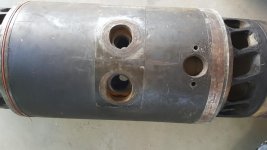If you had no ready-made means of gauging the threads, there are a few ways to go about determining what the thread is.
1. Determine the pitch (threads/inch): use a thread or screw pitch gauge, and see how many threads/inch the injector port threads are.
If you do not have a screw pitch gauge, you might use a series of bolts of various pitches, not to get the actual thread size/pitch,
but simply as screw pitch gauges. Use the bolts to see which thread pitch drops in and matches up to the pitch of the threads in the
injector ports. Obviously, the bolts will be a lot smaller than the injector port diameters.
2. Using something like a telescoping gauge, "capture" the inner diameter of the injector port and then use an outside micrometer to
mike across the telescoping gauge. This measurement will give you the "root diameter" of the threaded hole.
3. Do the math to "work backwards" from that root diameter. I.E.: if you have determined how many threads per inch the port has, then,
Depth of thread = 0.6495 x (1/n) where n = number of threads per inch.
Outer diameter of the thread = (root diameter) + ( 2 x Depth of thread)
4. Put the number of threads/inch, determined in step 1, above, together with the outer diameter calculated in step 3, above,
and you have your thread data.
5. Get a chunk of scrap steel or aluminum and chuck it in your lathe. Turn one end slightly larger than the root diameter you
miked, and keep skim cutting and trying it in the threaded bore until it just enters snugly. Re-run your numbers using this
diameter to get the "final" outer diameter of the injector body thread.
6. Turn the other end of that piece of stock to the "final" outer diameter as determined in step 5, above. Then, using your lathe,
set it to cut the number of threads/inch you determined in step 1, and cut the thread to the depth calculated in step 3, above.
This piece of scrap is your gauge. Try it in the injector ports. If need be, set it back up in your lathe and "pick up the thread"
with your threading tool and skim a few thousandths off the threads and re-try it on your cylinder liner ports. If it enters
with a good fit, not too tight, not too sloppy, you are there. Note how deep you finally cut the threads.
7. Get some steel round stock like A-36 hot rolled (which is readily weldable), and machine two diameters to the OD of the threads,
leaving a good shoulder. Use a parting tool or a toolbit ground to cut a "neck" with a radius'd end, cut a groove or undercut\
at the base of the shoulder. This will let you run the "plugs" you are making into the holes and seat them solidly.
Cut the threads to the depth you noted and put a chamfer on the ends of threads and you are there.
8. Cut the larger/unthreaded sections of each plug to whatever length and size you need for attachment to your support stand.
9. Cut some soft copper (roofing flashing works for this) to make gaskets for your "plugs". Anneal this soft copper. Run the plugs in
tight using a pipe wrench on them. The soft copper is what F-M used for injector gaskets. It will help seat the plugs you made
solidly against the cylinder liner.
10. Weld whatever you decide upon to each projecting plug to support the cylinder liner.
11. If you choose to support the cylinder liner from within:
-make the plugs as detailed above, but mill hex flats on them where they project on the outside of the liner, or machine them
to suit your own eye and ideas.
-make the threaded sections a bit longer.
-either make some nuts to screw onto the threaded sections, or drill/tap down the center of the threaded section of each plug for a bolt.
The heavier the better.
-cut come "clip angles" from heavy steel angle iron, drilled to slip over the threaded sections of each plug- if you made nuts to fit
them. Or, drill the angle to pass over bolts that will be screwed into the ends of the threaded portions of each plug.
The longer you make the threaded ends of the plugs, the higher the bending stress will be in them if you support the liner from inside
it.
-attach your support stand to these clip angles. I imagine you want to put the support stand inside the liner so it appears to be
floating rather than having a stand outside it. A-36 steel is machineable and weldable and cheap. I'd steer clear of cold rolled
as it is not the best thing to run structural welds on.
I can't resist adding this thought: Rather than your going thru all the steps to determine what thread is in the liners, perhaps you can ask
your buddy at the powerplant to borrow a spare injector. You can then get the thread data from it and save some work.




